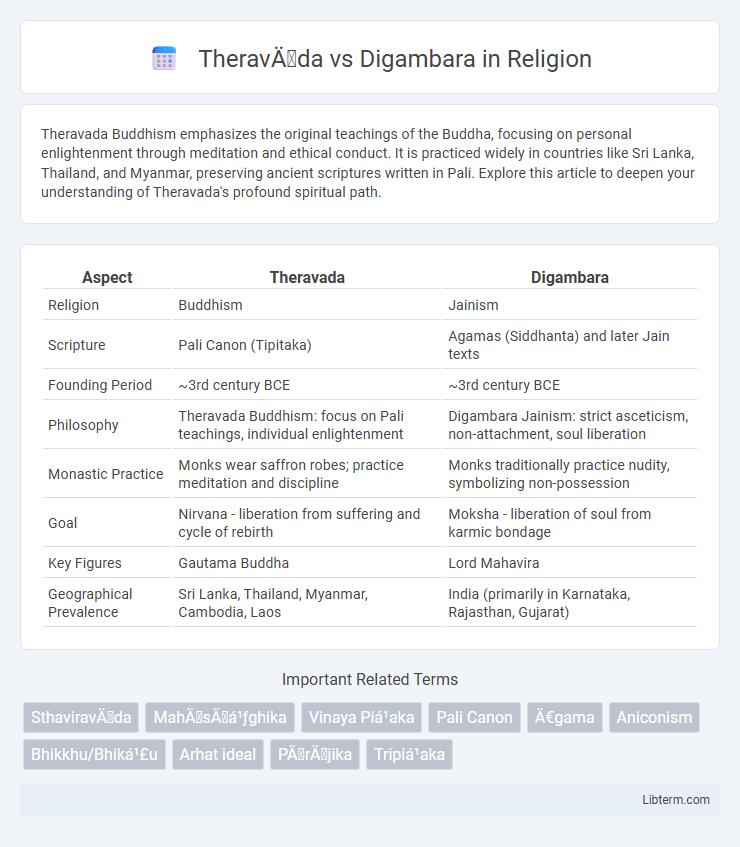Theravada Buddhism emphasizes the original teachings of the Buddha, focusing on personal enlightenment through meditation and ethical conduct. It is practiced widely in countries like Sri Lanka, Thailand, and Myanmar, preserving ancient scriptures written in Pali. Explore this article to deepen your understanding of Theravada's profound spiritual path.
Table of Comparison
| Aspect | Theravada | Digambara |
|---|---|---|
| Religion | Buddhism | Jainism |
| Scripture | Pali Canon (Tipitaka) | Agamas (Siddhanta) and later Jain texts |
| Founding Period | ~3rd century BCE | ~3rd century BCE |
| Philosophy | Theravada Buddhism: focus on Pali teachings, individual enlightenment | Digambara Jainism: strict asceticism, non-attachment, soul liberation |
| Monastic Practice | Monks wear saffron robes; practice meditation and discipline | Monks traditionally practice nudity, symbolizing non-possession |
| Goal | Nirvana - liberation from suffering and cycle of rebirth | Moksha - liberation of soul from karmic bondage |
| Key Figures | Gautama Buddha | Lord Mahavira |
| Geographical Prevalence | Sri Lanka, Thailand, Myanmar, Cambodia, Laos | India (primarily in Karnataka, Rajasthan, Gujarat) |
Introduction to Theravāda and Digambara
Theravada Buddhism, primarily practiced in Sri Lanka, Thailand, and Myanmar, emphasizes the Pali Canon as its authoritative scripture and advocates for individual enlightenment through strict adherence to the Buddha's original teachings. Digambara, a major Jain sect predominantly found in India, highlights asceticism with monks traditionally foregoing clothing to symbolize renunciation and believes that true omniscience is attainable only after liberation. Both traditions represent profound spiritual paths within their respective religions, rooted in rigorous discipline and doctrinal purity.
Historical Origins and Development
Theravada Buddhism traces its historical origins to the early teachings of Siddhartha Gautama, established in Sri Lanka during the 3rd century BCE through the missionary work of Mahinda, the son of Emperor Ashoka. Digambara Jainism developed in ancient India around the same era, emphasizing asceticism and non-possession, with roots linked to the teachings of Lord Mahavira in the 6th century BCE. Both traditions evolved through distinct monastic codes and doctrinal interpretations, shaping their unique cultural and religious identities over centuries.
Core Philosophical Differences
Theravada Buddhism emphasizes the Four Noble Truths and the Eightfold Path as the primary means to attain Nirvana, focusing on individual enlightenment through meditation and ethical conduct. Digambara Jainism centers on the principles of non-violence (ahimsa), asceticism, and the belief that liberation requires renunciation of all possessions, including clothing, symbolizing complete detachment. While Theravada underscores the impermanence of self and phenomena, Digambara upholds the eternal soul (jiva) and its purification as essential for liberation.
Scriptural Texts and Languages
Theravada Buddhism primarily relies on the Pali Canon, known as the Tipitaka, written in the Pali language, which is considered the oldest complete Buddhist scripture. Digambara Jainism's sacred texts are written mainly in Prakrit and Ardhamagadhi languages, with core scriptures including the Satkhandagama and Kasayapahuda. These linguistic distinctions highlight divergent scriptural traditions, with Theravada emphasizing Pali texts and Digambara preserving Jain teachings through ancient Prakrit manuscripts.
Monastic Practices and Discipline
Theravada Buddhism emphasizes a strict adherence to the Vinaya Pitaka, with monks practicing alms-rounds, meditation, and celibacy following detailed monastic codes to maintain spiritual purity. Digambara Jain monks observe rigorous asceticism, renouncing all possessions including clothing, practicing non-attachment through severe fasting, meditation, and non-violence (ahimsa) as fundamental disciplines. Both traditions prioritize rigorous self-discipline and renunciation, but Theravada monasticism focuses on mindful conduct and community living, while Digambara monasticism centers on extreme austerity and absolute detachment from materialism.
Rituals, Worship, and Lay Participation
Theravada Buddhism emphasizes meditation and monastic discipline with minimal ritual complexity, focusing on Vipassana and Dana (almsgiving) as core lay practices. Digambara Jainism involves elaborate rituals such as Pujas, Pratikramana, and fasting ceremonies, highlighting the rigorous asceticism of monks who renounce all possessions, including clothing. Lay participation in Theravada centers on supporting the Sangha and observing the Five Precepts, while in Digambara tradition, laity perform rituals, maintain strict ethical conduct, and offer symbolic items to Tirthankaras to accumulate spiritual merit.
Views on Enlightenment and Liberation
Theravada Buddhism emphasizes personal liberation through the realization of Nibbana achieved by following the Noble Eightfold Path and cultivating wisdom, ethical conduct, and meditation. Digambara Jainism views liberation (moksha) as the soul's release from karmic bondage through strict asceticism, non-attachment, and self-discipline, with enlightenment attained by shedding all karmic particles. Both traditions prioritize individual spiritual effort but differ significantly in their metaphysical frameworks and practices leading to ultimate liberation.
Iconography and Artistic Expressions
Theravada Buddhist art emphasizes simplicity and aniconism, often using symbolic representations such as the Bodhi tree, footprints of the Buddha, and the Dharma wheel rather than direct depictions of Buddha. In contrast, Digambara Jain art is characterized by highly detailed and ornate images of Tirthankaras portrayed in nude form, symbolizing renunciation, with distinct iconographic attributes like the Srivatsa mark and specific hand gestures (mudras). Artistic expressions in Theravada often focus on narrative reliefs and naturalistic styles, while Digambara sculptures highlight intricate carvings and idealized human forms to convey spiritual purity.
Geographic Spread and Influence
Theravada Buddhism predominates in Southeast Asian countries such as Sri Lanka, Thailand, Myanmar, Cambodia, and Laos, where it deeply influences local cultures and religious practices. Digambara Jainism, a major sect of Jainism, is primarily found in India, especially in states like Rajasthan, Karnataka, and Maharashtra, shaping regional religious landscapes. The geographic concentration of Theravada Buddhism in Southeast Asia contrasts with the Digambara sect's confinement mainly to the Indian subcontinent, highlighting their distinct cultural and religious impacts.
Contemporary Relevance and Dialogue
Theravada Buddhism, predominantly practiced in Southeast Asia, emphasizes monastic discipline and Pali canonical texts, shaping its contemporary social and ethical frameworks. Digambara Jainism, mainly found in India, upholds strict asceticism and the principle of non-possession, influencing modern discussions on environmental sustainability and non-violence. Ongoing interfaith dialogues between Theravada Buddhists and Digambara Jains foster mutual understanding by exploring shared values such as compassion, mindfulness, and ethical living in addressing global challenges.
Theravāda Infographic

 libterm.com
libterm.com